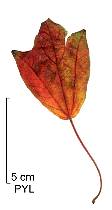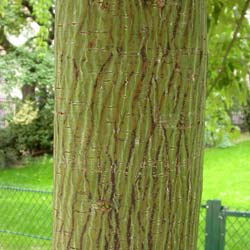 the Maples of Asia: Acer buergerianum, Maple with dragon bark
Origin: the East of China, Japan, introduced into Europe in 1890.
Habitat: altitude.
Hardiness: zone 6 (it supports cold until -23 °C or -9 °F).
Size: 10-12 m in Europe, 20 m in Asia.
Spreading Form, often shrub.
Bark : gray to light beige sometimes tinged with orange.
Leaves: simple, smooth margin (or slightly toothed), lobed with three very visible veins in the centre of every lobe. They get nice colours orange to bright red in autumn. The petiole is long (3-7 cm), and so long as the blade. Their form recalls that of the trident, hence the English name "maple Trident".
Small, yellow-green flowers, grouped in corymbs, appearing in April-May, at the same time as leaves or a bit afterwards.
Fruits: 1,5-2,5 cm samaras, wings with acute angle, which pass from the green to the red then to the reddish-brown to maturity.
|
Acer acuminatum
Acer buergerianum
Acer capillipes
Acer cappadocicum
Acer carpinifolium
Acer davidii
Acer ginnala
Acer griseum
Acer grosseri hersii
Acer japonicum
Acer palmatum
Acer pycnanthum
Acer rufinerve
Acer shirasawanum
|

![]()

![]()